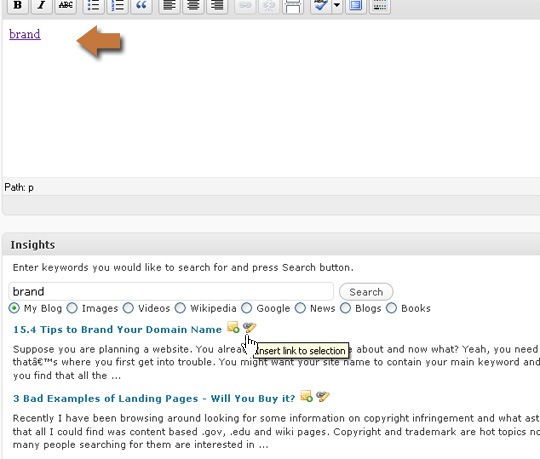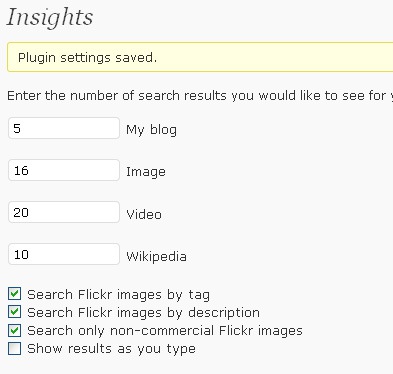- Google Quickly Uses Twitter @anywhere on Follow Finder
- Blogging for Bucks: 8 Tips to Earn Pay for Your Say
- Google Now Lets You Replay Popular Tweets
- Google Improves its Twitter 'Updates' Search Feature
- New AdWords Features Explained
- Wordpress Plugins to Interlink Your Blog Content Efficiently
- Content and Usability
- Creating Urgency in Your Sales Copy
- More Recent Articles
- Search Search Engine Journal
Google is definitely showing its all out support to Twitter. Aside from the
Google Replay feature which lets you view past tweets related to your current Google search results, Google has also launched
Google Follow Finder.
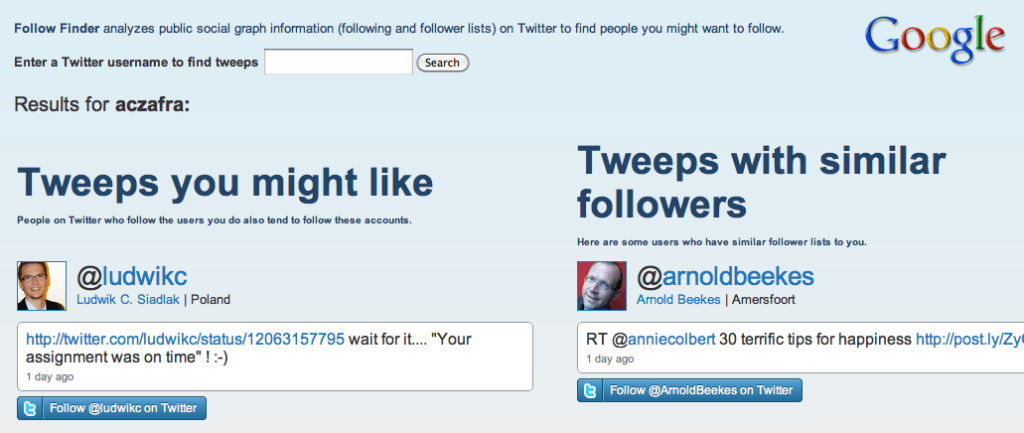
Available right now on Google Labs, Google Follow Finder makes it easier to
find and follow Twitter users which you may choose to follow. Yes, this is definitely different from those “autobots” that automatically makes you follow people whenever they follow you unless you made it a prerequisite to have your approval first before following people on Twitter.
Using Google Follow Finder, you simply need to enter your Twitter account and the online tool will give you other Twitter members who are not yet in your following list. It’s now then up to you whether you will follow them or not. It also works if you enter other people’s Twitter account. You can do all this without visiting your account on Twitter.com.
Google Follow Finder utilizes Twitter’s new @anywhere frameworks which was just announced today at the Chirp conference for Twitter developers. Twitter’s @anywhere makes it easy to add Twitter functionality to any websites or blogs.
So now at least, the next time you want to find people to follow on Twitter, you’d have a chance to choose which one are interesting and which one are not. Incidentally, if you are not yet following me on Twitter, you can add me up – @aczafra. You might find my “auto tweets” quite interesting.
Check out the
SEO Tools guide at
Search Engine Journal.
Google Quickly Uses Twitter @anywhere on Follow Finder



Unless you've been living up under a rock lately, you've heard of the Internet phenomenon known as blogging.
What many people don't know is that blogging is no longer just a recreational pursuit for folks to vent their repressed feelings, showcase their creative work, or promote a personal agenda. It's been elevated to an art form and an avenue where authors establish their expertise, expand their platforms, and savvy writers get pay for their say.
Since I started, I've had the pleasure of being paid to produce blog posts on everything from jazz reviews, to personal opinions, to how-tos.
And you can too.
But there's a method to it.
Even though it's not a "perfect science" it does require a systematic approach.
Here's how to work it:
- Do your homework. Study other blogs—the popular ones and the new kids on the block. What makes them successful? Where do they miss the mark? What's the tone? The word count? The take-away value?
- Write right and write tight. Blogs categorically require a different type of writing than other genres of writing. Most are more informal and conversational in tone. Very few call for word counts of over 700 words per post.
- To hone your skills and establish your expertise, do a few guest posts on other blogs. Ideally the ones that boast a high fan base and are considered leaders in the blog field. Doing so gives you credibility, visibility, and success by association.
- Network-–Just like in the corporate arena, sometimes it's not what you know but who you know that can make the difference. Tap into your available resources and folks who are in-the-know through Facebook, Twitter, and online communities in which you interact.
- Follow directions to find the road to success. For example, if a blog ad for a paying gig calls for 2 samples of 500 words and a resume, don't send one sample of 1000 words and links to work you've created on line. It's the easiest way to get fired before you're hired!
- Make it brief-–When applying for work, or presenting your work for consideration, be brief but substantive. Recognize that less is sometimes more.
- Have goals and a game plan. How much would you like to earn monthly? Yearly? Which blogs are the ones you aspire to write for and how often? What will your niche be? Is there anyone who can serve as a mentor to advise and guide you? These are a few key questions to consider.
- Write what you know-–The traditional philosophy of writing also applies with blogging. Pen posts on topics with which you have experience and familiarity. Of course, this doesn't mean you should never venture into new territories or attempt to expand your knowledge base. You should. But make that one of your future goals once you establish some footing and a fan base.
Here are a few places that you can find work in the blogging field:
Check out the
SEO Tools guide at
Search Engine Journal.
Blogging for Bucks: 8 Tips to Earn Pay for Your Say



Want to go back in time and read those famous tweets that were indexed by Google? Well, actually Google did not just index those tweets, it has in fact archived them and are now giving you the chance to
read those tweets again via Google search.

So, starting today, you can now zoom in to any point in time and replay what people have posted on Twitter about various topics that hit the headlines at some point in time. This will be featured on the “Show Options” on Google search results page. Once you’ve click this option, you will have to select “Updates.” Once you’ve selected that, Google will then display the all familiar latest and greatest Twitter updates that it has indexed. On top of those tweets is a new chart showing year, month or day categories. You can then select any particular point in that calendar and Google will display the tweets that were posted during that period.
What’s cool about that chart is that it also gives you the relative volume of tweet on a particular subject on a specific date. This is particularly useful if you want to review what has happened in the past and how people on Twitter reacted to those events.
This replay feature will be gradually roll out globally in the coming days. In the meantime, if you want to try it out, Google provided this special
link.
Check out the
SEO Tools guide at
Search Engine Journal.
Google Now Lets You Replay Popular Tweets



Short update! Google is a monster when it comes to searching. One thing that attributes to their all encompassing search features is that they are insistant on working with real-time search results and updates. It was announced recently that along with the ability to search updates for Twitter results, you’ll now also be able to search back in time to see a cluster of results from a certain time period.
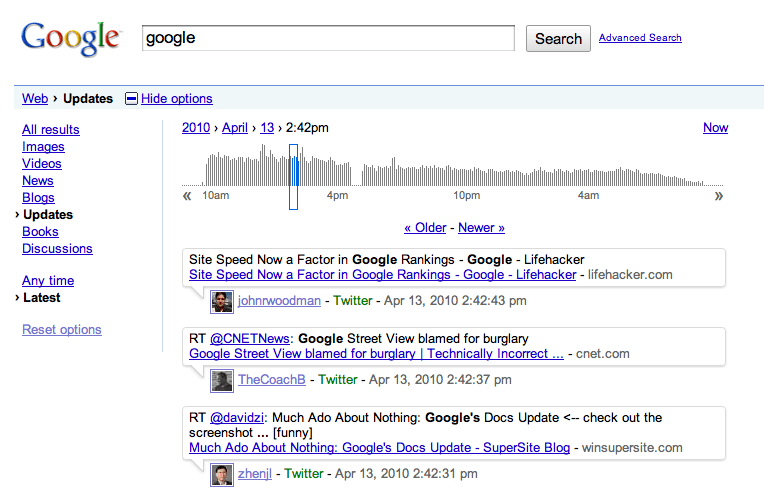
This is helpful if you just heard about a recent movement or news but missed out on the trending topics or social media waves that it was making. The features are not available currently- they’ll be rolled out in the next few days- but there’s a
test page available with limited search results. I tried searching a few things but they weren’t showing up… finally I used the search term “Google” and got something :)
Realizing the importance that social media trends and real-time results have in our world today, the
Google blog stated:
“All of us are just beginning to understand the many ways real-time information and short-form web content will be useful in the future, and we think being able to make use of historical information is an important part of that.”
I personally can’t wait for this feature to roll out… I’m pretty nosy when it comes to social media trends but I’m not such an excellent multi-tasker that I can follow
everything the minute they happen! I can however: work hard, drink coffee, use Gtalk, post on SEJ and tweet in one swift motion :)
Check out the
SEO Tools guide at
Search Engine Journal.
Google Improves its Twitter ‘Updates’ Search Feature



Here is a look at some of my new favorite features in Google AdWords. I'll review IP Exclusion, Traffic Estimator Beta, and Search Funnels.
IP Exclusion
We all hate it when a client, boss, or executive calls asking why the ads are not showing. How much more annoying is it when you find you account executives or other company staff clicking on your ads? Want to stop a particularly pesky competitor from seeing your ads?
You can stop it all, on most of the Google Search Network that is. A network site might not always be able to detect IP addresses, so be aware of that. But setting this up is simple.
Step 1
Make sure you are signed into your Google Account and go to
https://adwords.google.com/select/Tools
Step 2
Click on the IP Exclusion Tool (7th down, left side for me)
Step 3
Choose a campaign
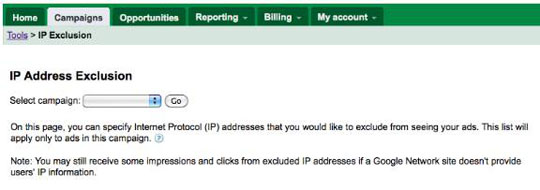 Step 4
Step 4
Enter the IP addresses you want to block (up to 20)
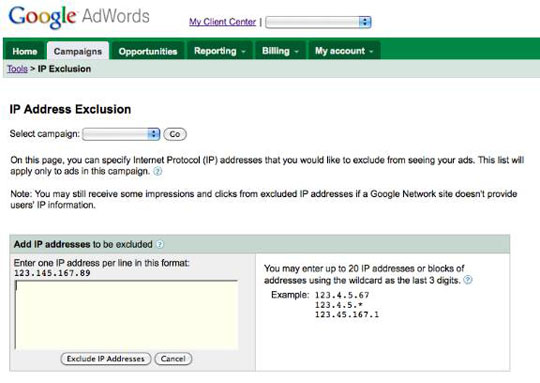 Step 5
Step 5
Rinse and Repeat (aka do it again for the other campaigns)
Traffic Estimator
There is a beta of this tool (which is why I am saying "new") that is in the new format. This is a great tool to use when you are planning new campaigns, launching a new product, or pitching a new client.
Step 1
Make sure you are logged into AdWords and head over here:
https://adwords.google.com/select/TrafficEstimatorSandbox
Step 2
Click on the link to the new version.
 Step 3
Step 3
Grab your keywords (you have them ready right?), as many as you want, and dump them in the first area. Pick a CPC and set the budget based on what has already be decided by people who are not you. Kidding. If you don't know leave these two blank.
Step 4
This is where I don't like this tool much. Geography. Be sure that is set to the right country and language. It just won't do real geolocation estimates yet. *sigh*
Step 5
Hit "Estimate" and Viola! Per day cost estimates at your fingertips. (No, my client will NOT be spending this much per day.)
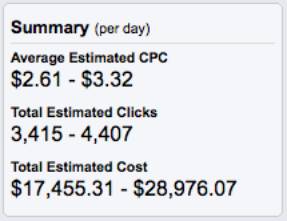
Search Funnels
This tool is so new that none of my clients have it yet, and there are some large limitations on it. But the data that could be shown is powerful.
There is a debate right now about what should get the credit for a conversion. Currently, only the last action gets the credit, when it is more likely that the conversion was due to a number of factors over time.
Google is attempting to aide in this issue by giving advertisers access to the bid keywords in which a Google.com searcher triggered the advertiser's ad leading up to the conversion from AdWords. See the restrictions in that sentence?
- Bid keywords – not the actual search query but the phrase that the advertiser was bidding on at the moment of the click. Naturally we would all hope to see the actual search query someday, but we might not because of user privacy issues.
- Triggered the ad – it only counts if the user triggered your ad. That means any related searches they might have done when your ads were down, or too far down in the rotation won't show up.
- Conversion from AdWords – The conversion has to happen in AdWords. All data from organic results or those clicks or impressions not from Google.com are left out for now. Big kicker especially if you are bidding for terms you rank well for. Keep in mind there are many other instances where the user could have had interaction with your brand offline that influences their click choice. This is just a peek at user interface with your brand.
- Tracking – The conversion has to be tracked in AdWords or you have to sync up a Google Analytics account to AdWords.
- Time Restraint – The conversion has to happen within 30 days of any previous clicks or impressions.
Never the less, I am proud of Google for starting the process of getting us this data. Some people might scoff at Google for so many restrictions, but to that I say
watch this.
Do You Have Search Funnels?
To check if you are part of the beta test, login to your AdWords account.
Step 1
Go to the Conversions section of the Reporting Menu,
Step 2
See this? If you do, enjoy! If not, you can wait with me and everyone else.

Find out more about
Search Funnels and more at the
Google Inside AdWords Blog.
Check out the
SEO Tools guide at
Search Engine Journal.
New AdWords Features Explained



A couple of weeks ago I shared a handy
Wordpress plugin that helps to smartly interlink your blog content (best to naturally link to your categories and tags). The post was very well-received, so today I am following up with the overview of all
Wordpress plugins that help to (automatically) interlink your blog posts, pages and categories.
With this plugin you will be able to give a keyword and the destination page and it will be linked globally throughout the blog:
Settings:
- Set case sensitivity: By default the keyword “dog” will match “dog” and “Dog.” To disable this behavior, select “exact match.”
- Set the number of links per post: If you only want to link a keyword a certain number of times in a post, you may set this using the “Times” option.
- Set several destination URLs: If you would like a keyword to randomly link to one of several URLs, separate each URL with a bar ‘|’.\
- Set several keywords per one URL: If you would like to link multiple keywords to a URL, separate each keyword with a bar ‘|’. (Times will refer to each keyword not all combined.)
- Use nofollow: Optionally you can add “nofollow” attribute to the links (for example to external ones).
You can import multiple keywords from a CSV file:
Insights
This plugin makes it easier to find related posts while you are creating content.
The process looks as follows:
- While writing the post, single out related terms and keywords;
- Search your blog using Insights field under the WP post editor field;
- Add links to related posts with one click of a mouse!
Additionally, you can:
- Insert Flickr Images
- Insert Youtube videos
- Search and link to Wikipedia
- Search Google
- Search News
- Google Blog Search
- Insert a Google Map
Via settings you can configure:
- How many search results you want to see;
- Flickr search options;
- Google maps API key (if you need Google Maps search results).
More plugins I played with:
1.
Inlinks: hyperlinks any given keyword with any given URL. However there’s no way to set the number of links per page. Besides, attempting to delete one of the entries I got “You do not have permission” (so who does if I am an admin of that blog???)
2.
Interlinks: it says it interlinks posts “wiki-style” but in reality the wiki-style is actually the syntax. I don’t think it is really usable (maybe for some it isn’t!).
3.
Cross-linker (same for
KB Linker): seems to be installed and configured successfully but never hyperlinked anything (not sure what is wrong).
4. Any other you want me to test-drive?
Check out the
SEO Tools guide at
Search Engine Journal.
Wordpress Plugins to Interlink Your Blog Content Efficiently



It’s not always an obvious connection, but the content on your website affects its usability. How? The easiest way to think about it is by putting yourself directly in the user’s seat. Think about it.
You go to a website that provides search engine optimization services. Although you might decide to hire the person or company behind the site, right now you’re in the research phase. You’re looking for resources and information to help you make decisions about
how to best optimize your website, not necessarily
who the best person or company is to help you with that.
When you get to the site, you’re looking for helpful information, like what search engine optimization is all about, tips for improving the performance of your site, and first steps in optimizing your site for search engines. What would happen if you got there and only saw a brochure site – no information, no articles or blog entries, only information about the company or person who provided the search engine optimization services?
If you’re in the research phase, you keep looking. You move on to someone who actually provides helpful content on the topic. When you find that person or company, you stick around, combing through the available content, until you make a decision about how you want to proceed. Chances are, if you decide to hire someone, you’re going to at least give that person or company a shot at helping you, right? Why?
First, they know their stuff and have established themselves as an expert on the topic. Second, they’ve proven that they want to help their customers and followers by providing free resources and valuable content. Finally, they’ve proven (even subconsciously) that they value their own time and screen their clients by letting the content speak for their knowledge and expertise, as well as their philosophy surrounding that topic (if you don’t agree with them, chances are, you move on to someone else, saving you both valuable time and a lot of frustration).
Content increases your website’s usability by giving visitors exactly what they want:
- Information on the topic of your expertise,
- Faith in you as a service provider by demonstrating your knowledge and commitment to service, and
- Pre-screening to see if you’re the service provider for them.
Especially in the beginning, it can be counter-intuitive to think about “giving away the cow” by providing an arsenal of free information and advice, but these days, you have to think about the options. Either establish yourself as the go-to expert that is the most knowledgeable source on the topic, or your site visitors will leave very quickly in search of someone else who fits the bill.
Check out the
SEO Tools guide at
Search Engine Journal.
Content and Usability



Humans are apathetic creatures by nature. We don't bother to take action unless we're threatened. Back when we were wearing pelts and living in caves, a "threat" was a life or death situation – but our evolutionary roots are still there today. Except instead of saving our young children from a saber-tooth tiger, we're fending off sales messages that threaten to quickly snatch our cash right out of our wallets.
For online businesses – this is a state of mind we want to engage in our prospects. But the only way to do that with the printed word is to create urgency. Keep in mind that you have to start with an offer so unbelievably good – your buyer already instinctively wants it before they even reach for their credit card. No amount of urgency in the world will budge a bad product.
Likewise, saying you have "Only 5 Left" when it's really a digital product and there's an unlimited supply – will serve to do more harm than good to your business. I've actually known users who have seemingly bought "the last 5 copies" of a resale rights product so as to minimize their competition. Imagine their anger and disbelief when they refresh the page hoping to see "0 left" but instead getting the same "Only 5 Left!" message. Word travels fast on the internet if you don't back up your words with real action.
Create Urgency with Digital Products
There are several ways to create urgency in sales of digital products without being dishonest. You can limit the number of bonuses to the first X buyers or limit the timeframe that bonuses will be available. Remind them of the pain, insecurity or problem they'll keep facing without your product or service .
Enthusiastic, detailed testimonials can help create urgency too – but subconsciously reminding the buyer of how relieved/happy/secure they'll feel as a result of ordering. When someone reads a testimonial that shows concrete (and realistic results) – such as "
I was able to lose one dress size within just two weeks – a total of 10 pounds of pure body fat, gone!" your customer can't help but imagine themselves getting the same results.
Experimenting With Urgency Offers
No matter what you sell, it's crucial that you test different offers to see which ones people respond best to – and when. If the offer is only available for the next 24 hours – make certain (or have programming in place) that takes down the page when time is up (and puts up a mailing list form in case people missed out and want to be notified if or when the offer returns!) This way, you'll stay true to your original promise and create urgency via real scarcity, while bringing through interested leads who waited too long to act on
that particular offer.
What Has Worked for You?
What are some ways you've added urgency to your copy? What worked, and what didn't? Share your results in the comments below!
Check out the
SEO Tools guide at
Search Engine Journal.
Creating Urgency in Your Sales Copy



More Recent Articles

















